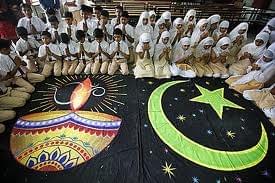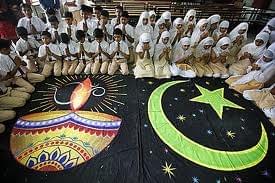Commentary
So which Islam are you talking about? (Part 2)
Satyananda
Dec 08, 2011, 12:05 AM | Updated Apr 29, 2016, 02:43 PM IST
Save & read from anywhere!
Bookmark stories for easy access on any device or the Swarajya app.


More on Deen
“Deen” is an Arabic creed, speaking the word of the Turk and the Persian, its ideology promotes a worldview, which is fundamentally opposed to all other worldviews, which considers non Muslims as Kaffirs and Dhimmis, and to that interpretation of Islam to which we must stand up to.
On the other hand “Islam panthis” centers of worship being at local dargahs, kankhas and mazhars, at the feet of the local pirs and babas, are part of our tradition and culture. It does not mean that there are no valid differences, there are, and they are many, but they are not based on different world views, unlike that between the Sanatana Dharma and the followers of the interpretation of the Deen.
Throughout history the majority of those who could broadly be classified as Islamic did not follow the creed of the Deen. They were the followers of Indic faiths and only accepted Islam nominally in matters of worship. As any one would tell you, the British, at the instance of the followers of Royal Creed and in order to create a permanent fifth column for their own ends, imposed with a vicious hand Sharia law on vast sections of the “Indian population”, all across India, who did not follow the Sharia, but “local customs” (euphemism for Indic traditions) from Kerala, to Bengal, from Central and United Provinces to the North Western Provinces, in the late 19th and early 20th Century, on the specious argument that there should be one customary law for all “Islamic” people based on Sharia as that was injuncted by “Islam” .
This for instance did not happen in Indonesia and till today therefore Indonesia can accept Ram and Sita as part of their own culture, and override Sharia through customary practice (Adat), while the Pakistani establishment actually abhors to even acknowledge that at some point of time, that there were people in the land known as Pakistan who followed Sanatana Dharma, and formulates “ Hudood Laws” directly replicating laws and mores of Saudi Arabia. Ironically Pakistan is the land of the Arya Varta (the most sacred of the lands in the Sanatana Dharma) .
Role of the British
The British through their history have always been on the side of the landholders and small royals, the emirs and the landed class, whom they could use for their own ends, to rule vast countries in which they were miniscule minorities. It was the case in Arabia as well, where the British used the same group to break up the Ottoman Empire, by cultivating and promoting the radically conservative Wahabism, against the existent multi-layered Islam of the Ottoman Khilafat. The small royals, the emirs and the landed class in India were naturally followers of the “Deen” and held “Islamic tareeka” in contempt. It was at their instance that the British went about creating “Islam” and “Islamism” as an ideology, to balance the growing “Hindoo nationalism” which still remains the ghost which haunts the Indian establishment.
It was this act of the British to create an Islamic ideology and then pick its own leaders who represented that ideology, and then in the name of the ideology appoint these handpicked men the leaders of the entire “Islamic” community, through a careful and selective choreographed political process, which led to the politics of “Islam is in danger” and partition. Those who stood up to their machinations like Fazlul Haq in Bengal and Khan Abdul Gaffar Khan in the North West Frontier Province were deliberately sidelined where they could not be genuinely maligned as unrepresentative of the “Islamic” community. The problem with us is we did not see through it then, and we do not see through it now.
Indian State
The new Indian state which came into independence after the British, continued to humor the representatives of the intolerant Royal Creed,like the assorted Mullas, Maulvis, Imams and small time Badshahs and Nawabs that were left in India after the partition . It is this indulgence, which has led us down to the polarization between a supposed “Islamic identity” and Sanatana Dharma. This polarization was inevitable as both world views are fundamentally different, and, it is impossible for them to co-exist harmoniously since they view their world and therefore their co-existence in very different ways .
Way Forward
I think it is therefore time that we for the first time after the British left India attempt to start speaking to the followers of the “Islam pantha” or the “tareeka” by actively engaging with its leaders and formulating a path to chart out our commonalities and our fundamental agreements, and our opposition to Royal Islam, and how “Islam” as a panth can validly be accepted as a Dharmic faith, which tolerates and has always tolerated “different modes of worship”. For that we have to deal with the shrines, the dargahs, the kankhas, the khadims and the peerzadas, who represent the vast majority of those who could be called “Islamic” in the country and deliberately actively ensure that the mullas,the imams, and the small time nawabs are kept out of the political process of the new political process of reconciliation . We have to keep out the poison of the Royal Islam and the Deen from flowing into the waters of the Ganga, as it would kill us all . I am sure it will not be easy, all around prejudices are many, and the followers of the Deen and their secular minions will not stop disrupting the process, but it is important that we start.
In this attempt we have to seek out new interlocutors who are not burdened with the past and are willing to forge a new identity based on new concerns and ancient realities .These interlocutors must be genuine representatives of the wide section of the members of their communities. To these interlocutors we should also be ready to lend a hand, as an older brother does to a younger. We have to be mindful of their concerns, their prickliness and their grievances, yet, we have to deepen and strengthen this process of commonality. We must also be firm about what we stand for, because no conversation is possible where the conversation is not based on firm principles. It will be a constant struggle and it would no doubt have it’s highs and lows, yet, we should continue the process without being either discouraged or flagging. We have dealt in a similar manner with the extremist propagators of Sikh identity, under grave provocations from those who are committed to the fragmentation of the Dharmic community for their own ends within and outside the community of the Khalsa Panth, and to our credit over a period, we have largely managed to bring out the fact that we share lots in common and we are an extended “ Dharmic” family, inspite of our differences in methods of worship.
Challenges
We also need to realize that the Deen is now as ever the part of the global “Ummah” and therefore flush with foreign funds and the support of the secular intelligentsia, media and political establishment, for whom it acts as polling agents and vote gatherers. The leaders and the benefactors of the Deen are therefore keen to ensure that the ideology of the Deen rapidly increases its influence amongst the little people, by creating and accentuating the grievances of the little people against others who follow similar culture and traditions and forcing them to confirm to a culture dictated by the Mullas and the Imams (who represent a completely different worldview, that of the Arab), in order to assume leadership of the entire community. It is fed by dreams to complete the project which was started from the time of Aurangzeb, that of changing Bharatvarsha to Khilafat-e-Hindustan. We are therefore in a race against time, against a very rich and powerful competitor for the “hearts and souls” of the followers of the little people who follow Islam as a method of worship.
Conclusion
Lastly, it is most essential that those who are known as liberal muslims and / or enlightened muslims, be kept out of the deliberations, since these muslims at the first and foremost owe allegiance either directly or indirectly to the Deen, and in any case speak in forked tongues to the followers of Dharma (to seem liberal) and the followers of “ the Deen” ( to seem Muslim), and unrepresentative of their community today, just as “Secular Liberals” are in ours . Secular Liberalism is a value system of the West and looking for “Secularism” as a means to converse with followers of the any faith outside western paradigms is plainly fruitless. A further case to note about “Secular Liberal Muslims” : Allamma Iqbal, Mohammadali Jinnah, et. al, considered themselves to be muslim secular liberals to the very end ( and look what they ended up promoting ) !!
In passing a last thought : Is it not important and right that the spiritual ( and need I say political ) representative of Islam in India, should be, the Khadim of the Dargah of Muin-ud-din- Chishti, the Gharib Nawaz, the patron of the poor, the founder of the way for the little people, wearing saffron, rather than the Shahi Imam of Jama Masjid, the Imam of the Mughal Imperial Court and the representative of a foreign and oppressive ideology, wearing his trade mark green .
(Concluded)
Image Courtesy- rina.in





